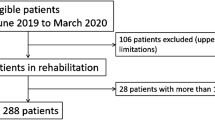Abstract
The intra-test and test-retest reliability of the Spinal Function Sort was assessed in a multisite study involving 180 disabled subjects. The results of this study demonstrate the reliability of the instrument across a variety of sites. In addition, this study demonstrated both differences in absolute scores and a pattern of reactivity to the instrument that suggests that perceived functional ability may be affected by the subject's degree of chronicity measured in terms of the time that elapsed between date of injury and datae of testing.
Similar content being viewed by others
References
White RW. Motivation reconsidered: The concept of competence.Psych Rev 1959; 66: 197–333.
White RW. The urge toward competence.Am J Occup Ther 1971; 25: 271–274.
Bandura A. Self-efficacy: Toward a unifying theory of behavioral change.Psych Rev 1977; 84: 191–215.
Bandura A. Self-efficacy mechanisms in human agency.Am Psychol 1982; 37: 122–147.
Christiansen C. Occupational therapy: Intervention for life performance. In Christiansen C, Baum C, eds.Occupational therapy: Overcoming human performance deficits (Chap. 1). Thorofare, NJ: SLACK Inc. 1991.
Smith MB, Competence and adaptation: A perspective on therapeutic ends and means.Am J Occup Ther 1974; 28 (1): 11–15.
Wiedenfeld SA, O'Leary A, Bandura A, Brown S, Levine S, Raska K. Impact of perceived self-efficacy in coping with stressors on components of the immune system.J Pers Soc Psychol 1990; 59 (5): 1082–1094.
Gayton WF, Matthews GR, Burchstead GN. An investigation of the validity of the physical self-efficacy scale in predicting marathon performance.Percept Motor Skills 1986; 63: 752–754.
Dolce JJ, Doley DM, Raczynski JM, Lossie J, Poole L, Smith M. The role of self-efficacy expectancies in the prediction of pain tolerance.Pain 1986; 27: 261–272.
Council JR, Ahern DK, Follick MJ, Kline CL. Expectancies and functional impairment in chronic low back pain.Pain 1988; 33: 323–331.
Shoor SM, Holman HR. Development of an instrument to explore psychological mediators of outcome in chronic arthritis patients.Trans Assoc Am Phys 1985; 97: 325–331.
Ewart CK, Taylor CB, Reese LB, DeBusk RF. Effects of early postmyocardial infarctions exercise testing on self-perception and subsequent physical activity.Am J Cardiol 1983; 51: 1076–1080.
Kirsch I. Efficacy expectations or response predictions: The meaning of efficacy ratings as a function of task characteristics.J Pers Soc Psychol 1982; 42 (1): 132–136.
Bandura A. Human agency in social cognitive theory.Am Psychol 1989; 44 (9): 1175–1194.
Armentrout DP. The impact of chronic pain on the self-concept.J Clin Psychol 1979; 35 (3): 517–512.
Millard RW. A critical review of questionnaires for assessing pain-related disability.J Occup Rehab 1991; 1: 289–302.
Gatchel RJ. Psychosocial assessment and disability management in the rehabilitation of painful spinal disorders. In Mayer TG, Mooney V, Gatchel RJ, eds.Contemporary conservative care for painful spinal disorders (Chap. 36). Philadelphia: Lea & Febiger, 1991.
Ryckman RM, Robbins MA, Thornton B, Cantrell P. Development and validation of a physical self-efficacy scale.J Pers Soc Psychol 1982; 42 (5): 891–900.
Lorig K, Chastain RL, Ung E, Shoor S, Holman HR. Development and evaluation of a scale to measure perceived self-efficacy in people with arthritis.Arth Rheum 1989; 32 (1): 37–44.
Feuerstein M, Papciak AS, Hoon PE. Biobehavioral mechanisms of chronic low back pain.Clin Psychol Rev 1987; 7: 243–273.
Matheson LN.RISC tool sort. Woodland Hills, CA: Rehabilitation Institute of Southern California, 1979.
Matheson LN.WEST tool sort. Signal Hill, CA: Work Evaluation Systems Technology, 1981.
Anzai D.Loma Linda University activity sort. Signal Hill, CA: Work Evaluation Systems Technology, 1984.
Matheson LN, Matheson M,Spinal function sort. Rancho Santa Margarita, CA: Performance Assessment and Capacity Testing, 1989.
United States Department of Labor.Handbook for analyzing jobs. Washington, D.C.: Manpower Administration, 1972.
Matheson LN, Matheson M.Spinal function sort examiner's manual. Rancho Santa Margarita, CA: Performance Assessment and Capacity Testing, 1991.
Kielhofner G.A model of human occupation: Theory and application. Baltimore: Williams and Wilkins, 1985.
Author information
Authors and Affiliations
Rights and permissions
About this article
Cite this article
Matheson, L.N., Matheson, M.L. & Grant, J. Development of a measure of perceived functional ability. J Occup Rehab 3, 15–30 (1993). https://doi.org/10.1007/BF01076739
Issue Date:
DOI: https://doi.org/10.1007/BF01076739




